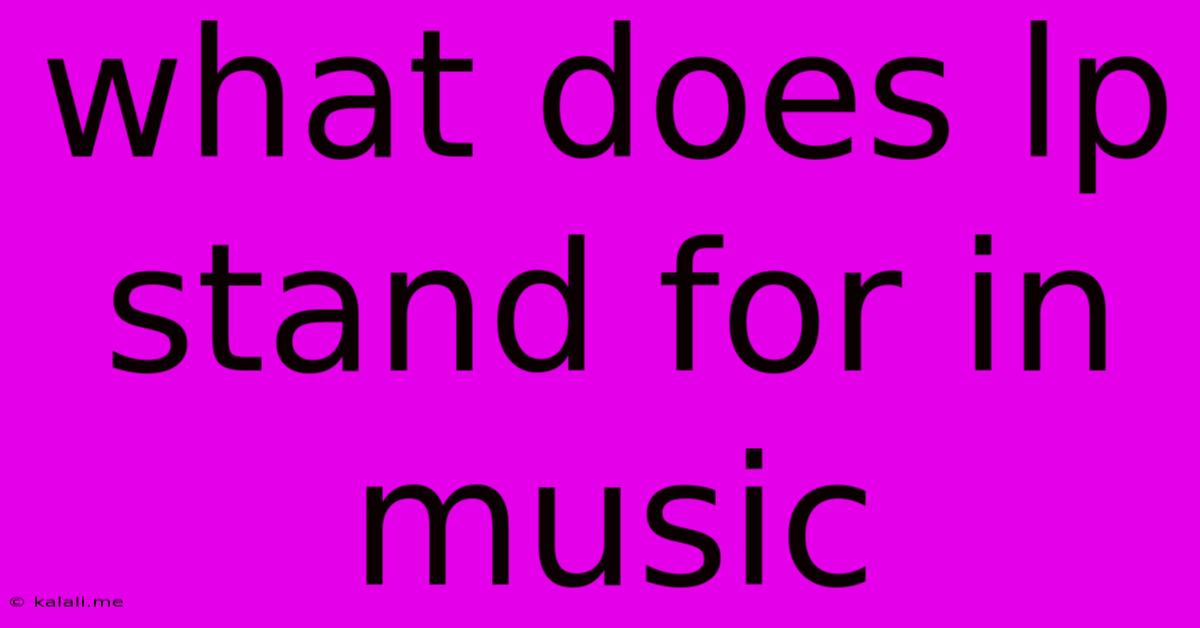What Does Lp Stand For In Music
Kalali
Jun 02, 2025 · 3 min read

Table of Contents
What Does LP Stand For in Music? A Deep Dive into Long Playing Records
So, you've heard the term "LP" thrown around in music discussions, maybe even seen it on a record store shelf, but aren't entirely sure what it means? This article will clear up any confusion and delve into the history and significance of LPs in the world of music. Essentially, LP stands for Long Playing record. Let's explore this further.
The History of the Long Playing Record
Before the advent of the LP, the standard for recorded music was the 78-rpm record. These were limited in playing time, typically holding only around three minutes of music per side. This made them impractical for longer musical pieces or albums. The development of the 33⅓ rpm LP in the late 1940s revolutionized the music industry. This new format, championed by Columbia Records, allowed for much longer playing times – around 20-30 minutes per side. This was a game-changer, allowing for the release of complete albums, symphonies, and extended musical works for the first time on a single disc.
This shift had a profound impact on how music was created, consumed, and perceived. Suddenly, artists could tell more complete stories through their music, and listeners could experience the full arc of an album's concept. The emergence of the album as an artistic statement rather than just a collection of individual songs is directly linked to the arrival of the LP.
LP vs. Other Record Formats: Key Differences
It's important to distinguish the LP from other record formats. While the term "vinyl" is often used interchangeably with LP, it's actually a broader term referring to the material the record is made from. An LP is a type of vinyl record, specifically one that plays at 33⅓ rpm. Other vinyl formats include:
- 78-rpm records: These are the predecessors to LPs, offering much shorter playing times.
- 45-rpm records: These were typically used for singles, featuring one song per side.
The Enduring Legacy of the LP
Despite the rise of digital music formats like CDs and MP3s, the LP has experienced a remarkable resurgence in recent years. Many music enthusiasts appreciate the warmer sound quality often attributed to vinyl, the tactile experience of handling the record and its cover art, and the ritualistic nature of listening to an entire album from start to finish. This renewed interest in LPs underscores their enduring cultural significance and their place in music history. For many, the LP is more than just a format; it's a symbol of a specific era and a way to connect with music on a deeper level.
Beyond the Physical Format: The "LP" in Digital Age
Even today, the term "LP" is still often used in a broader sense to refer to an album, regardless of its format. You'll often see artists releasing their "digital LP" or referencing an "LP's worth of material" even if there's no physical vinyl involved. This shows the lasting influence and vocabulary the LP has created in the music industry.
In conclusion, while LP stands for Long Playing record, its significance extends far beyond its technical definition. It represents a pivotal moment in music history, shaping the way artists create and fans consume music. Its enduring popularity showcases the enduring appeal of this iconic format.
Latest Posts
Latest Posts
-
How Do You Change A Fluorescent Bulb
Jun 03, 2025
-
Do People Think Squares Are Healthy
Jun 03, 2025
-
Good Mistakes For Characters To Make
Jun 03, 2025
-
Top O The Mornin To Ya
Jun 03, 2025
-
Was Wolverine Born With Bone Claws
Jun 03, 2025
Related Post
Thank you for visiting our website which covers about What Does Lp Stand For In Music . We hope the information provided has been useful to you. Feel free to contact us if you have any questions or need further assistance. See you next time and don't miss to bookmark.